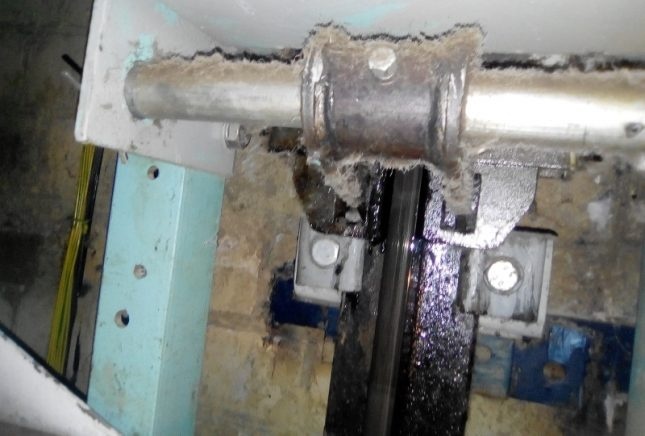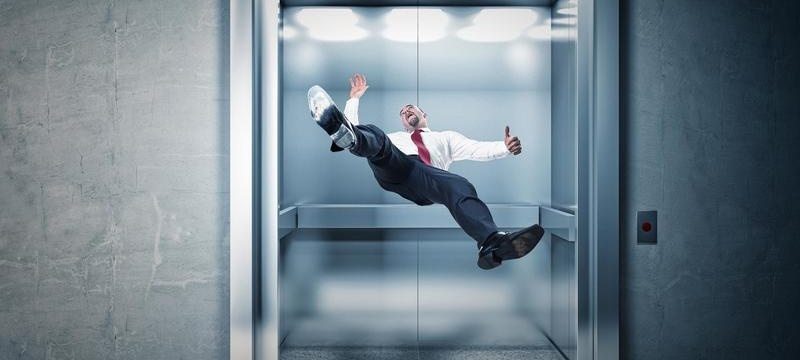Falling into the abyss: is it possible to survive in a falling elevator?

Surely you have at least once had a frightening, but fleeting thought that the elevator you are traveling in may fall. What are the chances to survive in such an accident? Let's try to figure it out.
Is it possible to survive in a falling elevator
Yes, in many cases there is a chance that you will remain alive, even if the cable breaks. For the safety of passengers, several technologies are provided, including a double cable and a spring in the shaft.
The elevator car is usually mounted not on one but on two or more cables. Moreover, each of them is able to withstand the weight of the cabin with passengers. If one of the cables breaks, the elevator will tilt and stop moving, but will not fall. Passengers will have the opportunity to call the emergency service and wait for the brigade in a banked cockpit.
A spring (or several springs) is usually located at the bottom of the shaft. It is designed to soften the blow in the event of a fall.

Of course, these springs will slightly reduce the force of impact, but theoretically they can save a life
But the main technology that protects passengers from death is the system of automatic braking of the elevator. If the cabin begins to fall, a mechanism is triggered, which more or less smoothly stops it in the mine. Even if it does not work completely and does not stop the cab, it can significantly reduce the rate of fall and the strength of the subsequent blow.
The invention of such a catcher belongs to Elisha Otis, who came up with the idea of attaching a spring to the roof, which is attached to the cable, which without tension (when the cable breaks) bends and turns into a spacer that stops the lift from falling. Now this invention is much more complicated, but the essence remains the same - when the cable breaks, a block appears that does not allow the cabin to move down the shaft.
A huge role in the chances of survival is played by the height from which the elevator falls. So, when falling from the 3rd floor, even without taking into account the spring, there is every chance to get by with “only” broken legs. But if the elevator falls from the fifth floor and higher, then here the risk of perishing increases sharply.
How to save life in a falling elevator
So, here are a few simple tips to help you survive an emergency:
- if the elevator is tilted (one of the cables broke) - do not jump, do not stomp and generally try to maintain a static body position. If you need to move to call the brigade, do it as smoothly as possible;
- if the elevator falls from a small height (3rd – 6th floor), bend your knees by 40 degrees. This will slightly reduce the impact that will be made on vital organs. True, this will not work if you fall from a great height, but if you fall from the 4th – 5th floor, the effect may be noticeable. Agree, it is better to break both legs than die;
- if the fall time allows, some advise such a technique - lie on your back and cover your face with your hands to protect yourself from splinters. Of course, there are risks here. Firstly, the chance of getting a serious head injury is significantly increased.Secondly, upon impact, the floor of the cabin can turn into a pile of sharp debris that will damage vital organs. However, ceteris paribus it is believed that this is the position of the body that will provide you with the maximum chance of survival. True, the chances of remaining an incompetent citizen are also incredibly increasing.
Do I need to jump at the moment of collision
There is a story that it’s enough to just jump at the moment the elevator collides with the bottom of the shaft - and that’s all, there will be no blow. Or it will, but very softened. Unfortunately, this is a myth. Even if we assume that you could accurately calculate the time before the impact in a closed cabin (which is extremely unlikely, given that the elevator rarely falls for more than 4-5 seconds), we still have to compete with ordinary physics.
A person in an elevator falls at a speed of about 35 m / s for the fifth second after a cable break. The Olympic champion's jump speed is about 2.5 m / s. However, you are unlikely to be an Olympic champion. And let’s not forget that your body doesn’t press on the floor with all its weight - because you fall not only in relation to the shaft, but also in relation to the cabin. Therefore, pushing with all your strength and jumping at a speed of 2.5 m / s will not work - the jump speed will be cut by about a third. But even if a miracle happens, and you can break the world record in an emergency, then acceleration is still not enough to soften the blow - you will continue to fall at a speed of more than 30 m / s.
Stories of survivors
In 2016, in China, in the city of Shenzhen, a man miraculously survived after falling from the 30th floor. It is not known for what reason the elevator broke down, but the Chinese miraculously survived. An important role in his survival was played by the fact that immediately after the fall, the man promptly called an ambulance - otherwise he could have died from his injuries.
And in 2018, the Russian became the victim of the fall of the elevator. In a Moscow forty-story residential complex, a man flew in a broken elevator of 20 floors and remained alive. He was saved by the automatic braking of the elevator - otherwise his “free flight” would last twice as long, and a successful outcome would be much less likely.
In 2012, in St. Petersburg, two passengers of a falling elevator (height is not specified) escaped with craniocerebral injuries and fractures, but remained alive. They were saved in time by the triggered automatic braking system.
Your survival in a falling elevator is not up to you. At this fateful moment, everything is decided by the quality of automation, the reliability of security systems and the height at which the cables broke.



